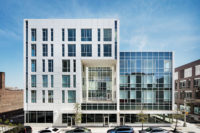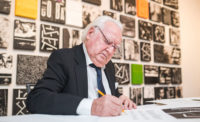In October 2016—more than 20 years after his initial sketches were completed—Pritzker Prize–winning architect Richard Meier has completed his first bridge, which links the heart of Alessandria, Italy, to the city’s 18th-century citadel across the Tanaro River. The reason for the long delay? “Bureaucracy,” Meier says. The new structure replaced a Napoleonic-era bridge deemed unfit for long-term use after floodwaters backed up behind its piers and breached the road deck in 1994, says project manager Simone Ferracina. Multiple agencies had to approve a replacement due to its historic nature, and the demolition wasn’t given the go-ahead until 2012. (One arch of the old bridge was preserved in place on each bank of the river.)
Meier calls his elegant new precast-concrete and painted-steel structure, rendered in his signature white, “a bridge between the past and the future” for Alessandria, a city of 94,000 residents that sits about 60 miles southwest of Milan. It’s the only bridge that leads directly to the 50-acre Cittadella of Alessandria, a six-pointed star fort whose walls stretch in a hexagon shape along the western bank of the river. The complex has been on Italy’s list for consideration as a UNESCO World Heritage Site for more than a decade, but its structures are crumbling. Officials hope that restoring the connection between this one-of-a-kind site and the Piazza Gobetti in Alessandria’s historic core will create a groundswell of support for preserving and adapting the citadel for new uses, which would help revive the local economy.
Designed with assistance from local architecture firm Dante O. Benini and engineering firm Arup, the 607-foot-long bowstring arch bridge has two spans that hold each other in check structurally. The vehicle deck, which curves to the north, is counterbalanced by both the separate pedestrian deck to the south and the south-tilting, 107-foot-tall arch that supports them both. The new walkway of ipé decking, which ranges from about 16 to 46 feet wide, has become a popular gathering spot; in contrast, the old bridge was usually so traffic-clogged that it was unsafe for pedestrian use.
Between the roadway and the walkway, an almond-shaped opening permits views to the churning water below. “Acoustically, the sound of the river is amplified five times because of that gap,” says Ferracina. “We’d love to take credit for planning it that way, but it was a happy accident. It helps drown out vehicle noise for pedestrians.”
Though some Alessandrians were slow to warm to the idea of erecting a modern bridge in place of an old one, most locals have embraced the city’s new icon with gusto, even bestowing on it an unofficial name: “the Meier Bridge.” As the arch took shape during construction, city officials launched a photography contest that challenged residents to snap pictures of it from their homes and workplaces. The response was overwhelming. “We knew the bridge would be visible throughout the city, but we didn’t realize just how visible until seeing thousands of pictures pour in from all different vantage points,” says Ferracina.
“I wanted this project to bring a sense of unity back to Alessandria,” Meier says. Mission accomplished.







Post a comment to this article
Report Abusive Comment